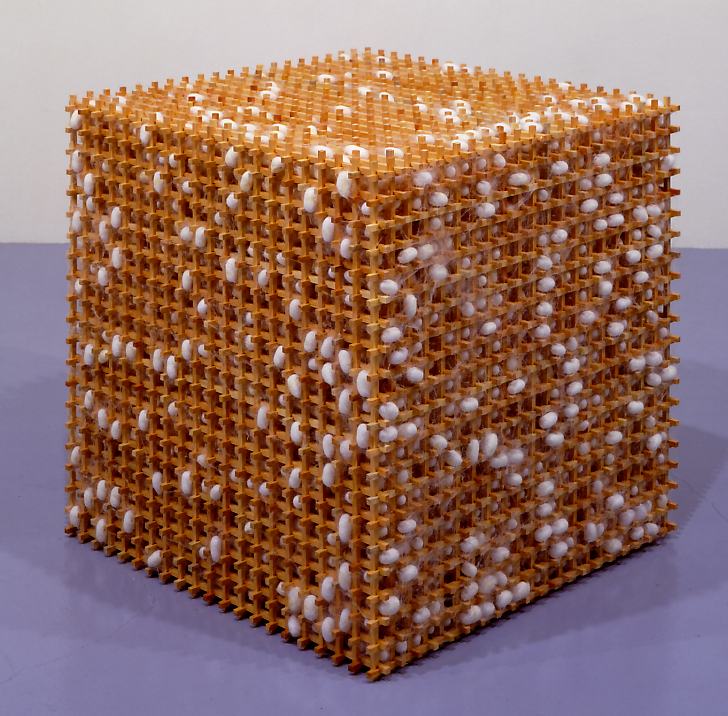| Artweek Reviews Los Angeles / Chuck Nicholson March 21, 1987 Volume18,Nomber 11 WORKING WITH NATURAL PROCESSES |
 |
| Kazuo Kadonaga, Silk No 2 D, 1986. silk and pine, 29”×29”×29”, At Space, Los Angeles |
Since the early 1 970s Kazuo Kadonaga has been devising ingenious ways
to reveal the essence of natural materials. His first and most extensive
exploration was with wood; he then examined paper and bamboo. The material
and subject matter of his latest sculptures is silk − its color, texture
and process of creation. Like his previous works, those, now filling the
rooms at Space allow us quietly to contemplate and experience natural forms
and processes in entirely new ways.
As do his previous works, these show an elegant blending of opposing characteristics,
suggesting the Eastern belief in the union of opposites and the interrelatedness
of all things. They combine simplicity and strength of form with complexity
and delicacy of detail, stability wfth suggested movement and the balance
of completed form with the potentiality of raw material. The complex interplay
between man-made and natural, geometry and irregularity, order and randomness
is especially strong. As usual, Kadonaga marvelously blends the traditional
Japanese attention to craftsmanship and desire to act in harmony with nature
with the modem esthetics of conceptual and process art. This interest in
concept and process has allowed him to produce unique works while de-emphasizing
his role as a maker of forms. Although the natural colors, textures and
forms of these silk works are not quite as sensuous or striking as those
of his works in wood or bamboo, the use of natural processes is much more
dramatic.
To produce these works he first built intricate
frameworks of pine or cedar, then purchased a hundred thousand silkworms and
carefully placed them on the structures. During the forty-eight hours it took
for all the worms to settle into their spaces, the frameworks had to be turned
frequently so that the cocoons would be evenly distributed (the worms tend to
travel toward the top of the structures to find empty slots). Then, as in the
harvesting of silk, heat was used to kill the worms and preserve the cocoons.
Undoubtedly the simple geometric shapes of the frameworks
are inspired by and reflect the structures actually used in sericulture.
Although they are carefully constructed, slight variations given them a
handmade, functional character. They project a subtle tension between industry
and artistry which provides a perfect background for the “artistic” activity of
the silkworms.
One of the most
interesting aspects of these works is the remarkable variety Kadonaga has
achieved, given the limited amount of control he allowed himself. Most of the square or rectangular spaces in the grids are
occupied by a single cocoon; occasionally there are two cocoons in one opening,
and some cocoons are woven on the structure's exterior. The cocoons themselves
usually show subtle differences, but in a few works they have an almost machinelike
uniformity. The number of spaces left empty also varies from sculpture to
sculpture. Another interesting variation is provided by dense layers of threads
covering the outside of some pieces, as if many worms had crawled back and
forth over them looking for empty spaces in which to spin their cocoons.
The majority of the eighty-four works are wall-hung and
consist of one or a very few layers. Most effective, however, are the larger,
more three-dimensional pieces, some of which are freestanding. These provide
the most dramatic contrasts between monumental scale and delicacy of detail,
between geometric and random structure. They also produce a heightened sense of
texture − the most
important physical characteristic of the works.
The exhibit has been installed
with most of the works in one room, which makes an extremely crowded display.
Although this allows for easy comparison of the wide variety of framework
shapes and subtle variations of texture, it seriously detracts from the impact
of individual.